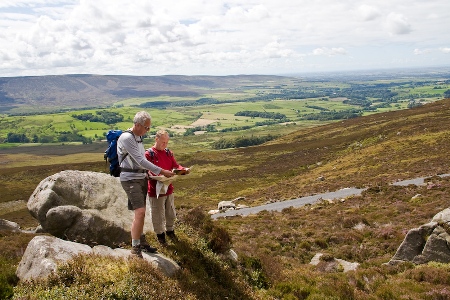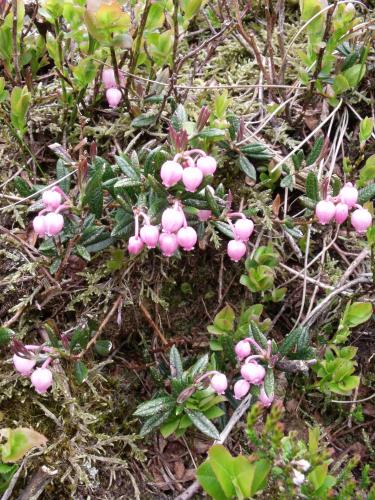
What is ‘natural beauty’?
’Natural Beauty’ is not just an aesthetic concept, and ‘Landscape’ means more than just ‘scenery’. It can include flora, fauna and geological and physiographic features. The natural beauty of National Landscapes is partly due to nature, and is partly the product of many centuries of human modification of ‘natural’ features. Landscape encompasses everything – ‘natural’ and human – that makes an area distinctive: geology, climate, soil, plants, animals, communities, archaeology, buildings, the people who live in it, past and present, and perceptions of those who visit it.

How is a National Landscape protected?
A National Landscape is designated and protected under the 1949 National Parks and Access to Countryside Act. Its protection is further enhanced by the Countryside and Rights of Way Act, 2000 (CRoW2000).
Each National Landscape has been designated for special attention by reason of their high qualities. These include their flora, fauna, historical and cultural associations as well as scenic views. National Landscape landscapes range from rugged coastline, dunes, salt marshes, peatlands, woodlands and estuaries to water meadows, gentle downland and upland moors.
The National Landscapes are a national asset containing a wide variety of attractive landscapes and like National Parks our National Landscapes are very much living and working landscapes that have been, and continue to be, shaped by nature and human activity.
There are 46 National Landscapes in Britain (33 wholly in England, four wholly in Wales, one which straddles the English/Welsh border and eight in Northern Ireland) and they cover 18% of our countryside.
National Landscapes are designated in recognition of their national importance and to ensure that their character and qualities are protected for all to enjoy. Visit www.landscapesforlife.org.uk
Read a joint publication about National Landscapes and National Parks - So much more than the view... and find out why they are regarded as a treasured natural resource and are internationally recognised for their special qualities.
Forest of Bowland National Landscape designation
 The primary purpose of the National Landscape desingation is to conserve and enhance natural beauty. In pursuing the primary purpose of designation, account should be taken of the needs of agriculture, forestry, and other rural industries and of the economic and social needs of local communities. Particular regard should be paid to promoting sustainable forms of social and economic development that in themselves conserve and enhance the environment.
The primary purpose of the National Landscape desingation is to conserve and enhance natural beauty. In pursuing the primary purpose of designation, account should be taken of the needs of agriculture, forestry, and other rural industries and of the economic and social needs of local communities. Particular regard should be paid to promoting sustainable forms of social and economic development that in themselves conserve and enhance the environment.
The Forest of Bowland designation highlighted several attributes that contribute to it's outstanding natural beauty:
- the grandeur and isolation of the upland core
- the steep escarpments of the Moorland Hills
- the undulating lowlands
- the visual contrasts between each element of the overall landscape
- the serenity and tranquillity of the area
- the distinctive pattern of settlements
- the wildlife and the landscape's historic and cultural associations
Fact File
- The Forest of Bowland National Landscape is situated in North West England, covering 803 square kilometres (312 square miles) of rural land in the counties of Lancashire (730 sq km) and Yorkshire (73 sq km).
- Designated as an National Landscape in 1964
- Important for its heather moorland, blanket bog and rare birds
- In 2005 the National Landscape became the first protected area in England to be awarded the European Charter for Sustainable Tourism in Protected Areas, and this honour was repeated when the Charter was re-awarded in September 2010. And in November 2011 the National Landscape were recipients of the prestigious 'Best Destination' runner-up award from The International Responsible Tourism Awards.
- The National Landscape's population of just 16,000 live mostly in its historic villages, with the remainder in loose-knit hamlets or isolated dwellings in open countryside. Some are estate villages where buildings are of a similar age and architecture, for example Downham, Slaidburn and Abbeystead
- The National Landscape encompasses 18 parishes within two counties, is host to six districts and four rivers.
- But where are the trees in the Forest of Bowland? The origin of the word 'forest' is from the Latin forestis silva where silva ( as in 'silviculture' ) meant woodland and forestis meant 'outdoor' . Commonly these were extensive areas of rough land on which the king or major landowner had the right to keep deer for hunting. These areas were subject to Forest Law in order to preserve game. As the home to several such 'Forests' – it can be seen that the 'Forest of Bowland' is closer to this historic meaning of the word forest than many of the woodland and plantations that might commonly be perceived as forests today.
What Makes the Forest of Bowland National Landscape Special?
The following themes link with the National Landscape's Sense of Place project and highlight the special qualities of the Forest of Bowland:
- Wild Open Spaces - a third of the National Landscape is moorland, making up the wild open spaces that are so characteristic and a unique quality of the area
- A Special Place for Wildlife - the moors in particular are an important breeding ground for upland birds. Thereare also notable wildflower meadows, woodlands and geological features
- A Landscape Rich in Heritage - much of the natural beauty is related to the wild and 'untouched' nature of the landscape - itself a result of hundreds, if not thousands of years of human activity
- Living Landscape - the landscape has been been formed out of a close relationship between people and nature, from the dry stone walls, hedgerows and barns to the open moors and grazed fields
- Delicious Local Food and Drink - local produce is important as it supports farmers who seek to manage this beautiful landscape and also supports the local economy as well as highlighting local distinctiveness
- A Place to Enjoy and Keep Special - highlights the importance of the area for people's livelihoods and enjoyment, with its value as a unique and protected landscape


